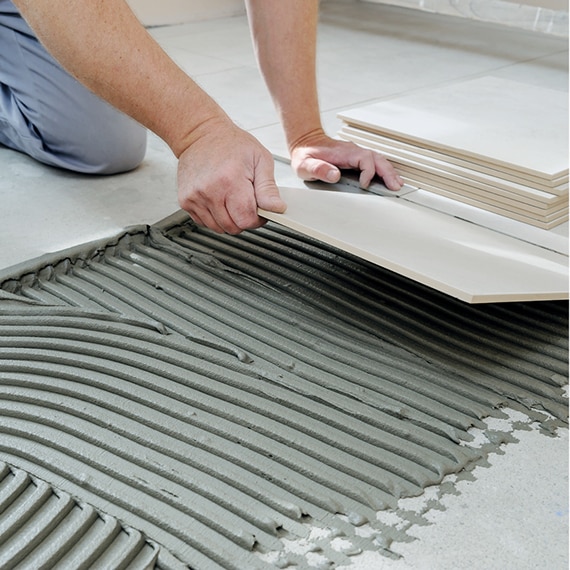Frequently Asked Questions
Care & Maintenance
-
What could be causing cracks to appear in ceramic floor tiles?There is always a remote possibility of an individual fractured tile, usually caused by not being bonded properly and then being impacted by an object dropping on it. That type of fracture is repaired by replacing the damaged tile. A sure rule of thumb to determining the problem: if the crack goes from one tile to another on a continuous line through the grout joint, the problem, without any doubt, is in the substrate; usually a crack in the slab. The damaged tile would have to be removed, a crack isolation membrane put down and the tile reinstalled; which should solve the problem.
-
What is the best way to clean abrasive quarry tile without leaving mop strings?First, with any abrasive tile, you cannot use a standard mop as it will be torn to shreds and leave strings on the floor. A nylon mop will not normally leave "strings" behind. MOST IMPORTANT: Make sure you always use clean water. Change as often as necessary. When cleaning this floor, it must be scrubbed daily (at least) with a brush and, if available, use a vac system (wet vacuum) to pull up the residue of water. At least once a week the floor should be cleaned with an electric floor scrubber. If no vac system is available, surplus water must be accumulated in one area and gathered up, or some commercial kitchens have drains for disposal of excess water.
-
After grouting with Epoxy (black), how can the black stains be removed from an unglazed paver or unglazed quarry product?Because of the course nature of unglazed pavers and unglazed quarry, additional precautions and a more exacting cleaning procedure is required, particularly when using dark grout such as black. If the grout is epoxy, this accentuates the necessity of the above referenced procedure. If the tile has yet to be grouted, it is recommended that a penetrating sealer be used, which will not change the look of the tile, but fill the small minute holes in the surface that trap the dark grout. This will assist in the clean up procedure. A basic point with all grouting procedures is not to grout a larger area than you can comfortably clean up prior to moving to the next section. (If you have helpers, do not get too far ahead of them.) If you are concerned about cleaning the black stain from an existing job that was not presealed, it will be with difficulty and you will probably not be able to remove it 100%. Although 90% should be cleanable with a heavy duty stripper such as Aqua Mix's "Sealer and Adhesive Remover." It will necessitate a stiff bristle scrub brush and/or nylon scouring pad and even steel wool can be utilized on more stubborn stains. You will, however, have minute black specs all over the surface where the grout, particularly epoxy, has entered these small holes and cannot be removed. Epoxy grout film does not respond to the acid cleaning methods used to remove regular cement grout film. It's resistance to cleaning depends on whether it has had time to reach full cure and on whether it is a pure epoxy film or a weak, water-contaminated residue. Therefore, it is best to attempt removal of epoxy film during the first day or two after grouting. The sooner it is done, the easier it will be. Three options for removing epoxy grout film from tile:
1. Household cleaner and scrub vigorously with a stiff scrubbing brush or power floor scrubber. Rinse thoroughly. Repeat as necessary.
2. Dampen a cloth with lacquer thinner from a paint or hardware store and apply to epoxy film. Promptly use a disposable cloth pad to remove softened film completely from tile surface. Repeat until all traces of film are gone.
3. If there are thick globs or layers of epoxy, to the point you cannot see the tile surface, use a 'heat gun' just long enough to soften this epoxy coating. Scrape or rub off until film is gone.
-
What is the best method to re-polish an old marble floor installation that is dull and scratched?Stone is made shiny by working the surface until it is smooth enough to reflect light. When the surface has been roughed up to the point that light does not reflect evenly, the marble looks dull and needs to be refinished. The first point is to determine the depth of the scratches. Deep scratches are not only visible, but can be felt with the fingernail. Light scratches can been seen, but not felt. If they are only slight, they can be buffed with a standard floor machine and a red pad. Deep scratches are removed by grinding/sanding the surface down until the scratches no longer show. The surface is then refinished with Multi-Seal Refinisher to bring the shine back. Once a floor is restored to it's original condition, a maintenance program should be set up and there are a number of companies that provide the components and instructional guidelines. We recommend Aqua Mix and Multi-Seal. There are major maintenance manuals available from both sources.
-
Where would unglazed be preferable over glazed ceramic tile and why?Unglazed ceramic tile is strongly recommended for most exterior horizontal (floor) applications, interior applications subject to standing water such as shower floors, for very high traffic floors such as airports, train stations, etc. Impervious porcelain tiles are recommended in all 'freeze/thaw' horizontal exterior applications, and even in vertical 'freeze/thaw' applications subject to standing (or in) water.
-
What type of tile is recommended for kitchen counter tops and why?Although a great variety of glazed tiles are used for counter tops, manufacturers specifically recommend only specific tiles. These are usually double glazed like American Olean's "Crystaltex" or glazes fired at higher temperatures, such as glazes on vitreous and porcelain bodies. High-gloss glazes are not recommended because they will scratch under normal kitchen counter top use. Many owners will select these 'high-gloss' tiles for counter tops even though they are told "they will scratch," because they like the look and do not intend to use their kitchen on a regular basis. American Olean includes specific references in our catalog for each product. Refer to American Olean's Product Catalog. Vanity Tops: Most tiles are all right to use, except the softest glazes, because of less abuse.
-
What is a 'Master Grade Certificate' and how is it obtained?
It indicates the manufacturer guarantees that tile meets and exceeds all the requirements as dictated in ANSI 137.1.
A 'Master Grade Certificate' can be obtained from the tile manufacturer or supplier upon request. If you want a certificate when picking up your order, request it in advance. This certificate must be signed by both the manufacturer and the installer.
Grout
-
What is the best way to clean grout?
NEW GROUT: Because cementitious grout is porous, sealing can help to keep grout joints clean. Allow grout to dry at least 48/hours, then make sure it is clean before sealing with a sealer recommended for grout.
EXISTING GROUT: A routine for cleaning grout should be established, as occasionally cleaning with household cleaners containing acid, bleach or even vinegar will etch the tile and grout in time. There should be two types of cleaning procedures, regular 'Routing Cleaning' with a concentrated non-acidic phosphate free cleaner and occasional 'Heavy Duty Cleaning' when dirty. We recommend for Heavy Duty Cleaning: Aqua Mix 'Heavy Duty Tile & Grout Cleaner.' NOTE: Epoxy grouts are not porous and are easier to clean; however, they are more expensive to purchase and to install.
-
What causes grout cracking?
There are several possible reasons for cracking grout:
• A flexible substrate (plywood, etc.)
• Poor installation; tile not bonded, resulting in loose tile.
• A non-sanded grout was used with the grout joints too wide. When the grout shrunk, the only possible thing it could do is crack.
• The grout joint was not completely filled during installation, leaving voids on the surface.
• In a large floor installation, where the grout crack is isolated in specific areas, it is usually caused by the lack of expansion joints. -
Can existing dirty grout be re-grouted?To merely apply new grout over existing grout is not the answer because it will always look like that is what you have tried to do without success.
You can re-grout if you dig out the existing grout and there are saws specifically designed for this purpose. However, be forewarned that it is a tedious and exasperating task and it is virtually impossible to do without damaging some of the tile, which would necessitate replacement. You would then probably have a problem matching the color shade of the tile. The saws are actually utilized either with fresh grout or a smaller area which needs re-grouting; thus they are not really practical for large areas.
The grout can be stained with a grout stain such as 'Grout Colorant' by Aqua Mix. Available in 22/normal grout colors, plus three vivid intense colors, Red, Yellow and Blue. -
What can be done to eliminate a white film or powder in grout joints?The white powdery layer you describe that most often reforms again after you brush it away is called efflorescence; which is simply white salt deposits. These salts remain on the grout joints when the salts in water solution are wicked to the surface and then the water evaporates, leaving these salts in powder form. It seeks out the porous grout joints because water cannot travel through glazed tile to the surface. Because it is difficult to say exactly where efflorescence comes from, it is just as difficult to say when it will stop appearing. These salts can originate in the grout, the mortar bed, the concrete slab beneath the mortar bed, or even in the ground under the slab. They have also been traced to unwashed sand containing soluble salts, sometimes to free alkalis in cement, occasionally to chemical concrete admixtures, and more recently to high alkaline floor cleaners which absorb into the joints and reappear as efflorescence. That is the reason they call your substrate, (ex. slab) "the hidden floor below." It can even be caused by a failure to install a moisture barrier between a source of the moisture (the ground) and the grout joints. Frequently the problem will reduce to a low level as the underlying moisture evaporates away. The bottom line, it is excessive moisture (more than normal) wicking through the porous grout joint.
The first step to eliminate the problem is to let the installation dry out and the cement cure. During this process, merely brush off the white powder which will leave a stain, but do not address the stain until the wicking (moisture transmission) stops. For the final cleaning and to remove the stain, agitate the grout joint with a brush and, if necessary, utilize a neutral cleaner such as Aqua Mix's 'Tile & Grout Cleaner.' If this fails to remove all of the residue, it may be necessary to use sulfuric or phosphoric acid. Sulfuric would be the acid of preference and three things are mandatory for either acid:
1. It must be diluted a minimum of 5:1 to 7:1.
2. The surface must be wet prior to administering the acid.
3. Be sure and wash thoroughly to remove all the residue of acid.
Allow this to dry and if no more efflorescence appears, seal the grout joint with a grout sealer. NOTE: If by circumstance it is a fast track commercial job, the same process would be followed, except you may not be able to allow it to dry out as much as possible.





